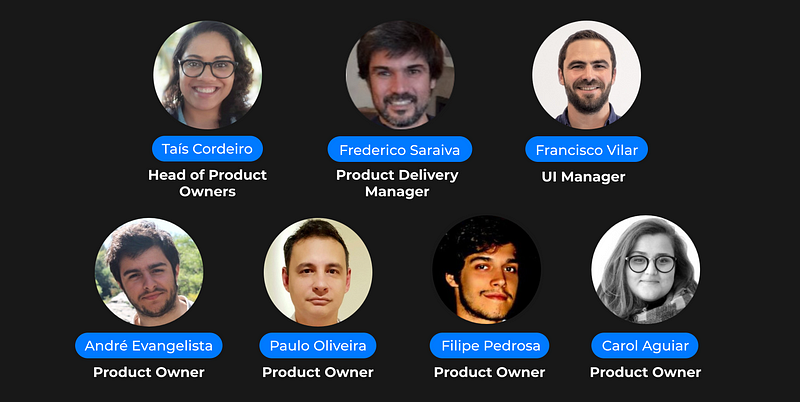We invited the Product Team at Lovys to explain what it actually meant to work in Product. What does a Product Owner do? What are their roles and how do they connect with other areas of the company? They accepted the challenge and are here to tell you all the deets. The stage is theirs 🎤!
Meet our Product Team!

The product team at Lovys
Behind every great product is a great product team. The product team is responsible for implementing the strategy, building the roadmap, and defining the product features. These are the people who pick what’s built, promote what’s new, and measure performance. And at Lovys it’s no different. Our product team is currently made up of seven people and continues to expand!
Taís is 30 years old, Brazilian, and has been working as a Head of Product Owners at Lovys since January 2020. Today she will share with us the daily life of the product team at Lovys.
What a product owner actually does at Lovys
Members of the Product team at Lovys are responsible for managing Lovys’ entire product portfolio — from strategically defining user requirements and managing feature sets to owning product life cycles from inception to launch and beyond.
Members of the team will often perform two main activities:
- Interface directly with different teams in the company: Insurance, Marketing, Operations, Partnerships and Financial teams. Not only to gather information about the performance of our existing technical solutions, but also to learn more about how Lovys products and services can be improved to meet our strategic company goals by satisfying our customers.
- Shape the backlog: that it’s about taking raw ideas, coming up with a mentally viable solution, and then supporting the development teams through the implementation phase, from the organization of actionable user stories and prioritizing the work in the backlog.
What’s the impact of your work to the different teams in the company?
We bring organization, vision and strategy to the entire company through our Product Roadmap. To ensure that the entire company works in the same direction, we seek to take the following questions to all areas:
• What are the top-priorities, right now?
• Why? What value do they bring to the product and how do they match up with our strategic objectives?
With the answers to those questions in mind, everyone starts to be aligned with the most important initiatives, because they are what drive and allow us to reach our key metrics and strategic objectives.
How do you create the bridge between engineering and business?
At Lovys, our product owners are responsible for facilitating high-level estimation sessions with the Engineering team.
First, the product owner meets with engineers to introduce the problem. When we present the issue, we explain why this item is important and why now is the right time to do it. To empower the technical team with the right mindset, we share the “why” behind what we’re trying to accomplish so that we can all operate from the same baseline. Armed with the correct background information, the engineering representatives access the problem through their lens to answer the question: how can we build a code that supports this?
After discussions and alignments, the Product and Engineering teams together are able to share with the Business areas:
“In (# weeks) we can deliver (the solution) and the benefit we think it will have for customers is (benefits).”
These high-level estimation sessions are meant to be collaborative to create between Product, Business and Engineering a clear perspective of the scope, value, how to measure it, complexity and possible delivery date.
What is the main challenge of doing this bridge?
Delivery forecast and deadlines.
Predicting results is one of the most difficult tasks that Product Owners undertake. There are so many variables and unknowns to consider that it’s nearly impossible to predict an accurate delivery schedule.
But despite its challenges, forecasting is an essential part of the Product Owner’s responsibilities. For example, if we can’t predict launch dates with decent accuracy, it becomes difficult for marketing to plan and schedule campaigns, and it’s harder to have conversations with leadership about strategy and priorities.
How do you create a good balance between short-term and long term initiatives?
In our product team strategy, we first set medium and long-term goals. This gives us a sense of direction and purpose. Then we start creating short-term goals that relate to long-term goals.
Our short-term goals are initiatives to be developed and delivered within a month; medium-term initiatives are our quarters and long-term initiatives refer to what we want to achieve in the semester and at the end of each year.
Short-term goals serve as steps to achieving our long-term goals. Short-term goals are simpler and easier to accomplish than long-term goals.
Achieving short-term goals gives us a sense of accomplishment that encourages us to achieve long-term goals.
This cadence allows us to have flexibility to reprioritize our backlog and roadmap, especially in the long-term.
How do you handle different opinions about the same product/project/initiative?
The use of various forms and forums of communication between the product team, senior management, and stakeholders increases opportunities for mutual understanding. These exchanges help Product Owners build alignment on stakeholder expectations and reduce the potential for conflicts throughout the project.
At the end of the day, it is all about customer value and lean solutions. Creating tangible customer value is paramount as a product owner. Also, be iterative and avoid spending a large amount of time designing and building the perfect solutions. Sharing the build-measure-learn mindset across the company helps us to create a product that can evolve constantly, measuring business expectations along with customer needs and market development.
We hope Lovys’ testimonial helps you understand a bit better about the role of a Product team, whether it’s in an online insurance company or any other sector. Check all their open positions to see what other areas they’re hiring for) 🚀






0 Comments